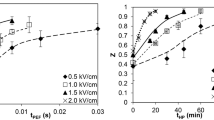Abstract
Two mixtures of refined sunflower seed oil, one with oleic acid and the other with olive oil distillates from a laboratory plant, were physically refined using nitrogen as stripping gas in a discontinuous deodorization pilot-plant scale installation (30-L capacity). Two heating procedures were tested: one using independent electrical heating for the oil and the gas distillates so as to maintain the same temperature in both, and another in which only the oil was heated and controlled, resulting in a difference in temperatures in the oil and the gas distillates. Two different oil temperature values and three nitrogen flow rates were also assayed. The statistical technique of blocking with paired comparisons was used to analyze the results. These results showed that maintaining the same temperature in the oil and gas distillates had a positive effect on free fatty acid distillation rate and vaporization efficiency. Oil temperature and nitrogen flow rate also influenced some of the aforementioned responses.
Similar content being viewed by others
References
Norris, F., Deodorization, in Bailey’s Industrial Oil and Fat Products, edited by T.H. Applewhite, John Wiley & Sons, New York, 1985, Vol. 3, pp. 897–930.
Ruíz-Menéndez, M.V., G. Márquez-Ruíz, and M.C. Dobarganes, Comparative Performance of Steam and Nitrogen as Stripping Gas in Physical Refining of Edible Oils, J. Am. Oil Chem. Soc. 73:1641–1645 (1996).
Ruíz-Méndez, M.V., A. Garrido-Fernández, F.C. Rodríguez Berbel, and E. Graciani, Relationships Among the Variables Involved in the Physical Refining of Olive Oil Using Nitrogen as Stripping Gas, Fett/Lipid 98:121–125 (1996).
Camacho, L., M.V. Ruíz-Méndez, and E. Graciani, Changes in Olive Oil Components During Deodorization and/or Physical Refining at Pilot Plant Scale Using Nitrogen as Stripping Gas, Fett/Lipid 101:38–43 (1999).
Graciani, E., J.C. Bada, F. Rodríguez, and M.V. Ruíz-Méndez, Physical Refining of Edible Oils Using Nitrogen as Stripping Gas. Process Optimization, Grasas Aceites 45:132–146 (1994).
Deffense, E., Refinación con Vapor: Comparación de la Teoría con la Práctica, Dossier Oleo:49–57 (1994).
Vian, A., and J. Ocón, in Elementos de Ingeniería Química, Aguilar, Madrid, 1964, p. 657.
Official Methods and Recommended Practices of the American Oil Chemists’ Society, 5th edn., edited by D. Firestone, AOCS Press, Champaign, 1998, Method Cd 3d-63.
Box, G.E.P., W.G. Hunter, and J.S. Hunter, in Statics for Experimenters, An Introduction to Design, Data Analysis, and Model Building, John Wiley & Sons, Inc., New York, 1978, pp. 93–106, 306–374.
Author information
Authors and Affiliations
Corresponding author
About this article
Cite this article
Prieto González, M.M., Bada, J.C., Graciani, E. et al. A comparative study of two heating procedures in the physical refining of edible oils. J Amer Oil Chem Soc 76, 1471–1476 (1999). https://doi.org/10.1007/s11746-999-0187-z
Received:
Accepted:
Issue Date:
DOI: https://doi.org/10.1007/s11746-999-0187-z




